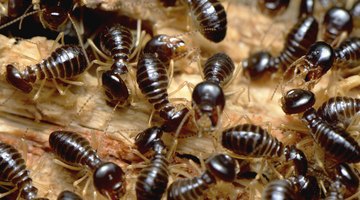Do Termites Attack Brick Homes on a Concrete Slab?
A brick house on a concrete slab might seem impenetrable to termites. These wood-destroying insects are known for tunneling through siding and other wooden portions of a home. Brick and concrete houses are a little more difficult for them to enter, but they're not a barrier to severe termite infestations.

Unless there's no wood in your home at all, termites will find something on which to feed.
Concrete Slabs
Concrete slabs actually are more vulnerable to invasion by termites than homes built on basements. The space underneath slabs provides darkness and a moist environment. Termites can be as small as 1/8 inch in length, and are capable of entering your home through expansion joints in the concrete, holes for plumbing, electrical wiring and other utilities, and through ordinary cracks in your slab. Seal all entry points, keep water away from your foundation edge and install a baiting system to reduce the risk of infestation.
Brick Veneer
Most modern brick homes are just brick veneer. These houses are built with a wood frame, just like any other home, then brick is applied to the surface instead of wood or vinyl siding. When moist soil or mulch leads up to the edge of your brick veneer, termites can actually travel behind the veneer and access the wooden structure underneath. They leave no obvious entry points, and can do a lot of damage before they're discovered. Texas A&M University recommends keeping soil and other moist soil-like materials at least 4 inches below the edge of any brick veneer.
Structural Brick
Older brick buildings, such as Victorian and other historical homes, may be built of structural brick instead of veneer. The walls lack a wooden framework and are supported entirely by the brick. Their walls tend to be several bricks thick, unlike veneer, which is usually composed of only one layer of brick. Few of these homes, however, contain no wood. Many homes with structural brick also have interior plaster over wood lath, which is fastened directly to the masonry with little to no space for insulation. Once termites enter through a crack in a brick or mortar, they have ready access to wooden elements inside your home. As with concrete slabs and brick veneer, keep the area around your foundation dry and reduce soil contact with brick elements.
Drywood Termites
Drywood termites can attack any home with wood inside, no matter the outside composition of the house. These termites usually come inside in a wooden object, such as a piece of furniture, picture frame or lumber. Unlike subterranean termites, they build their nests inside wood, and can live in your walls or even a table leg. Drywood termites can be treated using fumigation, heat or spot treatments. The best way to prevent them is to carefully inspect any wood you bring inside your home.
References
Writer Bio
G.D. Palmer is a freelance writer and illustrator living in Milwaukee, Wis. She has been producing print and Web content for various organizations since 1998 and has been freelancing full-time since 2007. Palmer holds a Bachelor of Arts degree in writing and studio art from Beloit College in Beloit, Wis.
Photo Credits
- DamSmith/iStock/Getty Images
- DamSmith/iStock/Getty Images
More Articles



